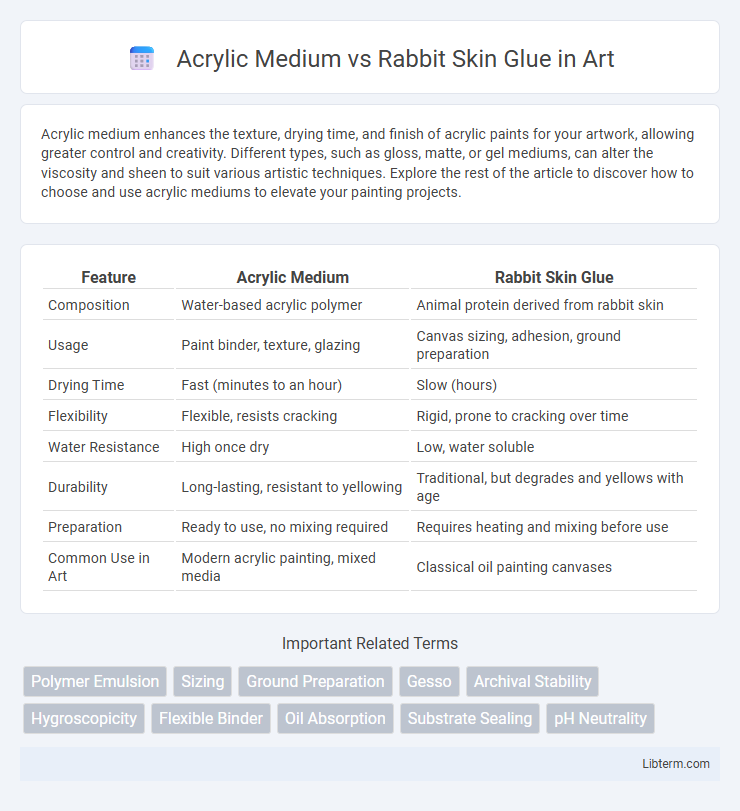Acrylic medium enhances the texture, drying time, and finish of acrylic paints for your artwork, allowing greater control and creativity. Different types, such as gloss, matte, or gel mediums, can alter the viscosity and sheen to suit various artistic techniques. Explore the rest of the article to discover how to choose and use acrylic mediums to elevate your painting projects.
Table of Comparison
| Feature | Acrylic Medium | Rabbit Skin Glue |
|---|---|---|
| Composition | Water-based acrylic polymer | Animal protein derived from rabbit skin |
| Usage | Paint binder, texture, glazing | Canvas sizing, adhesion, ground preparation |
| Drying Time | Fast (minutes to an hour) | Slow (hours) |
| Flexibility | Flexible, resists cracking | Rigid, prone to cracking over time |
| Water Resistance | High once dry | Low, water soluble |
| Durability | Long-lasting, resistant to yellowing | Traditional, but degrades and yellows with age |
| Preparation | Ready to use, no mixing required | Requires heating and mixing before use |
| Common Use in Art | Modern acrylic painting, mixed media | Classical oil painting canvases |
Introduction to Acrylic Medium and Rabbit Skin Glue
Acrylic medium is a versatile polymer-based substance used to modify the consistency, drying time, and finish of acrylic paints, enhancing adhesion and flexibility on various surfaces. Rabbit skin glue is a traditional animal-based adhesive derived from processed rabbit collagen, commonly employed as a sizing material to prepare porous surfaces like canvas for painting. Understanding the chemical composition and functional properties of both materials informs their appropriate application in fine art and restoration projects.
Historical Context and Origins
Acrylic medium emerged in the 20th century as synthetic polymers revolutionized art materials, providing artists with versatile, fast-drying, and water-resistant binding agents. Rabbit skin glue, dating back to ancient China and the Renaissance, served as a traditional natural adhesive made from collagen, celebrated for its strong binding and suitability for oil painting grounds and gesso layers. The historical transition from rabbit skin glue to acrylic medium reflects advancements in chemical technology and changing artist preferences toward durability and ease of use.
Composition and Chemical Properties
Acrylic medium is composed of synthetic polymers such as polymethyl methacrylate (PMMA), providing a flexible, water-resistant, and fast-drying binder ideal for acrylic paints. Rabbit skin glue consists of collagen proteins derived from animal hides, offering a strong but rigid adhesive that absorbs moisture and requires reactivation with water. Chemically, acrylic mediums exhibit high stability and resistance to yellowing, whereas rabbit skin glue is hydrophilic and prone to shrinkage and cracking over time due to its organic composition.
Application Techniques for Artists
Acrylic medium offers versatile application techniques, including glazing, impasto, and mixing with pigments to enhance texture and transparency in paintings. Rabbit skin glue, traditionally used as a sizing agent, requires careful heating and brushing onto canvas to create a rigid, absorbent surface that prevents paint absorption and improves adhesion of oil paints. Artists choose acrylic medium for flexible layering and quick drying, while rabbit skin glue is preferred for grounding surfaces in classical oil painting methods.
Surface Preparation: Canvas and Beyond
Acrylic medium offers versatile surface preparation by creating a flexible, non-absorbent layer ideal for canvases, wood, and other substrates, enhancing paint adhesion and durability. Rabbit skin glue, a traditional size, effectively seals natural fibers in canvas, preventing oil paint from deteriorating the fabric while providing a rigid, absorbent ground. Choosing between these depends on the desired texture, flexibility, and compatibility with subsequent paint layers, with acrylic media suited for modern mixed media and rabbit skin glue preferred for classical oil painting techniques.
Drying Times and Flexibility
Acrylic medium typically dries within 15 to 30 minutes, offering a flexible and durable finish ideal for mixed media applications. Rabbit skin glue requires a longer drying time, often several hours, as it needs to fully cure to provide its traditional rigid and absorbent surface. The inherent flexibility of acrylic medium reduces cracking risks, while rabbit skin glue's brittleness may cause flaking or distortion over time if used under flexible paint layers.
Archival Quality and Durability
Acrylic medium offers superior archival quality and durability due to its resistance to yellowing, cracking, and moisture over time, making it ideal for preserving artwork in diverse environments. Rabbit skin glue, a traditional binder, can become brittle and is sensitive to humidity changes, leading to potential deterioration and reduced long-term stability. Artists seeking longevity and protection against aging often prefer acrylic mediums for their consistent performance and archival reliability.
Health and Environmental Considerations
Acrylic medium is water-based, non-toxic, and emits minimal VOCs, making it safer for indoor use and environmentally friendlier than rabbit skin glue, which releases ammonia fumes and requires animal-derived ingredients. Rabbit skin glue, a traditional adhesive made from animal collagen, poses allergenic risks and demands careful handling due to its strong odor and potential airborne irritants. Choosing acrylic medium reduces health hazards and environmental impact, supporting sustainable and safer art practices.
Cost and Accessibility
Acrylic medium is generally more affordable and widely available in art supply stores and online, making it a cost-effective choice for artists. Rabbit skin glue tends to be more expensive and harder to find, as it is a specialized traditional adhesive often used in fine art and conservation. The synthetic nature of acrylic medium offers consistent quality and longer shelf life compared to the natural, perishable rabbit skin glue.
Choosing the Right Binder for Your Artwork
Selecting the right binder for your artwork hinges on understanding the properties of acrylic medium and rabbit skin glue. Acrylic medium offers flexibility, fast drying time, and water resistance, making it ideal for modern mixed media and durable surfaces. Rabbit skin glue, a traditional adhesive, provides strong adhesion and a rigid, archival base suited for oil painting on wood panels, but requires precise preparation to avoid brittleness and cracking.
Acrylic Medium Infographic

 libterm.com
libterm.com